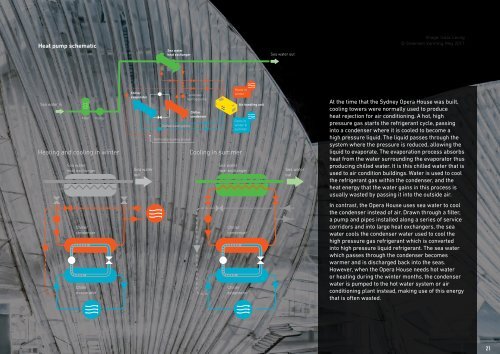CIBSE Australia and New Zealand 30th Anniversary
30 years and counting! Take a look back at CIBSE ANZ's accomplishments and achievements from the past 30 years.
30 years and counting! Take a look back at CIBSE ANZ's accomplishments and achievements from the past 30 years.
You also want an ePaper? Increase the reach of your titles
YUMPU automatically turns print PDFs into web optimized ePapers that Google loves.
Heat pump schematic<br />
Sea water<br />
heat exchanger<br />
Sea water out<br />
Image: Isaac Leung<br />
© Steensen Varming, May 2017<br />
Sea water in<br />
Filter<br />
Pump<br />
Heating <strong>and</strong> cooling in winter<br />
Sea water<br />
heat exchanger<br />
Chiller<br />
evaporator<br />
Sea water<br />
out<br />
Chilled water pump<br />
Artificially loading branch<br />
Condenser /<br />
heating pump<br />
Chiller<br />
condenser<br />
Heats in<br />
winter<br />
Air h<strong>and</strong>ling unit<br />
Cools in<br />
winter &<br />
summer<br />
Cooling in summer<br />
Sea water<br />
heat exchanger<br />
Sea water<br />
out<br />
At the time that the Sydney Opera House was built,<br />
cooling towers were normally used to produce<br />
heat rejection for air conditioning. A hot, high<br />
pressure gas starts the refrigerant cycle, passing<br />
into a condenser where it is cooled to become a<br />
high pressure liquid. The liquid passes through the<br />
system where the pressure is reduced, allowing the<br />
liquid to evaporate. The evaporation process absorbs<br />
heat from the water surrounding the evaporator thus<br />
producing chilled water. It is this chilled water that is<br />
used to air condition buildings. Water is used to cool<br />
the refrigerant gas within the condenser, <strong>and</strong> the<br />
heat energy that the water gains in this process is<br />
usually wasted by passing it into the outside air.<br />
In contrast, the Opera House uses sea water to cool<br />
the condenser instead of air. Drawn through a filter,<br />
a pump <strong>and</strong> pipes installed along a series of service<br />
corridors <strong>and</strong> into large heat exchangers, the sea<br />
water cools the condenser water used to cool the<br />
high pressure gas refrigerant which is converted<br />
into high pressure liquid refrigerant. The sea water<br />
which passes through the condenser becomes<br />
warmer <strong>and</strong> is discharged back into the seas.<br />
However, when the Opera House needs hot water<br />
or heating during the winter months, the condenser<br />
water is pumped to the hot water system or air<br />
conditioning plant instead, making use of this energy<br />
that is often wasted.<br />
Chiller<br />
condenser<br />
Chille<br />
evaporator<br />
Chiller<br />
condenser<br />
Chiller<br />
evaporator<br />
21


